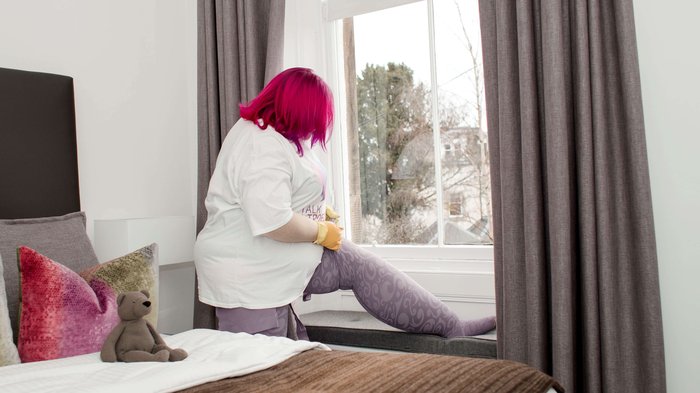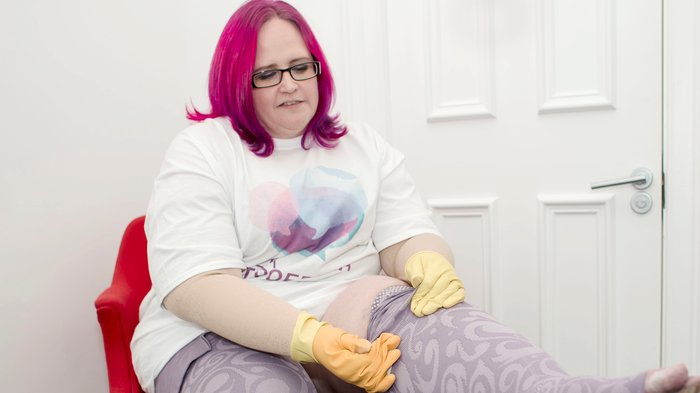Compression for lipoedema
Compression in lipoedema
Compression or compression therapy is used to manage symptoms such as pain, inflammation, and fluid accumulation (oedema) in people with lipoedema. This includes stockings, arm sleeves, tights, leggings, adjustable wraps, and sometimes bandaging.

How does it work?
Compression creates slight pressure over the skin, and in the lipoedema tissues. This improves the movement of blood up the leg veins. It also stops extra fluid leaking into the tissues from the blood and reduces inflammation in the area. Compression supports the lymphatics, which can reduce oedema. It may not have a direct effect on the lipoedema fat. Worn regularly will help to reduce symptoms of heavy limbs, pain and inflammation.
What is available?
There are many different types of compression, in different styles, shapes and strengths. Many companies have been developing specific garments for people with lipoedema. This means there is more choice for you. Mostly, you can get these on prescription, if your doctor or nurse will agree to prescribe them. Some people have to buy garments which can be costly.
There are many different garments and styles of garments available including:
- Stockings of all lengths, with open or closed toes
- Tights, and Capri or Bermuda style shorts
- Leggings without feet
- Arm sleeves
Some choices:
- Circular knit are knitted on a continuous loop and are smooth, but can be highly elastic and can feel tight
- Flat-knit are usually bespoke made with a seam; they have lower elasticity but higher pressures when you move. They are good if you have skin folds as are less likely to dig in and tourniquet
- Different colours; beige and black are standard but many different colours and patterns are coming available
- Compression class which is usually 1, 2 or 3 for lipoedema (3 is the strongest)
- Zips can be included if you have difficulty pulling on a garments
- Silicone bands can be included to help keep a garment in place; these can be hypoallergenic.

Some common problems and possible solutions:
I can’t get them on: this is common when you first get new garments as they are tight when new; you may need an applicator and gloves to help grip the material. See links below. Sometimes zips can be incorporated to make the garment easier to apply. It is also possible that they are the wrong size, so check with the prescriber.
They won’t stay up: this is also quite common, and it is important to make sure they are correctly pulled up at the start of the day. You may need adjustments, or different garments; some people use a roll-on glue. Sometimes two separate garments are helpful such as a below knee stockings and Bermuda shorts that are applied separately.
The silicone band is itchy: this is common if you are hot and sweaty, and your skin can become red. Ask about hypoallergenic bands, or check back with your practitioner, as you may need another style.
They feel hot: this can be a real problem in the summer heat; some materials include cotton or materials that enable them to ‘breathe’ and prevent heat.
My stockings only goes to the knee and it swells above that: this suggest that this is not the right garment for you; talk with your practitioner.
Here are some examples of compression application aids, but ask your practitioner for more detail on what is suits for you: https://www.daylong.co.uk/shop-by-category/application-aids.html.
What if I have problems with oedema?
Adjustable wraps are now available on prescription from most companies, can applied by you, and are useful for controlling oedema. These are made of a firm material, and have sticky straps that can be tightened as required. They can even be worn over stockings. They are available in a foot piece, calf piece, thigh piece and or knee piece. Sometimes, a course of bandaging will be used to reduce swelling and help to heal any skin breaks.
How do I choose what is best for me?
Choice of garment depends on your lifestyle, symptoms, your body shape, and what is recommended by the therapist. You are the best judge of what works but may ned to try different styles until you find those that are comfortable and work for you. Always get back to whoever supplied it if there are any problems as there will be something else available that works better. Talk to others to find out what they find useful. Some companies that supply for people with lipoedema are: medi UK (mediven cosy or mondi); Haddenham Healthcare (ETO grace); Jobst Elvarex; Juzo; Sigvaris. Many others are available, so there are various options.
What if I want to buy my own?
Yes, you can buy them but most companies will require you to be measured by a suitably qualified practitioner. Some people buy extra garments as the NHS usually only supplies two pairs every 4-6 months. They can be expensive, especially if the garments are complicated and require zips or inserts. You may have to sign a form to say you are VAT exempt.
There are also less compressive garments from companies such as Snag tights, that can be effective in supporting the lipoedema tissues.
How do I get measured correctly?
We advise being measured and fitted by someone who has been trained by the companies that make the garments. They will take length and circumference measurements, and the process take time. The details on the measurement form are usually sent via your doctor or prescriber with the prescription. Check the website of the companies as most have measurement forms freely available, with the codes. Most garments are made in central Europe so you may wait 2-3 weeks for them to be delivered.
In the UK, lymphoedema practitioners, tissue viability nurses or orthotic practitioners are the most experienced at measuring, and some practice nurses may also do measurements. You may need to strip down to your underwear so then can measure your hips, waist and the whole area of your legs.
When should I wear compression?
Some people wear compression daily. It is helpful especially if you are standing or sitting for long periods, or exercising. People who have lymphoedema with lipoedema should wear garments as often as required by their specialist. If you have had surgery, you maybe asked to wear compression every day, and overnight.
Most people say they cannot wait to take their stockings off towards the end of the day. On hot days, you may find you are more comfortable without compression. We recommend that you carefully monitor the effects of wearing compression. Try to have a variety of options to wear, depending on your activities, or the weather. If you stop wearing compression it is possible that your legs, arms or hips will enlarge and your garments will not fit you.
Applying and removing compression
This can take time every day, so it is good to develop a routine for doing this efficiently. They need to be applied correctly, using various techniques to pull them up fully, to avoid them sliding down again when you walk. Some companies can knit a functional knee zone into the garment that makes it easier to move without it pulling down. Others can include an insert of a soft silky material behind the knee or at the top of the inner leg, for example, to reduce friction.
Get someone to show you how to apply the garment correctly. Avoid over stretching the material, or risk tearing it with your nails. Wearing gloves to grip the material can be helpful. The garment can be applied inside out at the foot, gently eased over the heel, with each section being gently pulled up, section by section until you reach the top. Some tips:
- Put it on in the morning when any swelling is minimal, rather than part way through the day.
- Get yourself in a comfortable position before you start
- Find out about applicators such as the medi Butler/Valet, the Ezy-As, and the Easy-slide. These will all make application easier and make you more likely to wear the garment. It can take time to get used to using these but you will become quicker over time
- Wear a pair of household or gardening gloves that help to grip the material, minimising the risk of tearing
- Break yourself in gently; garments can feel tight when first used. Wear them for a shorter time to start with and gradually increase the time. They will slacken over time and wearing.
